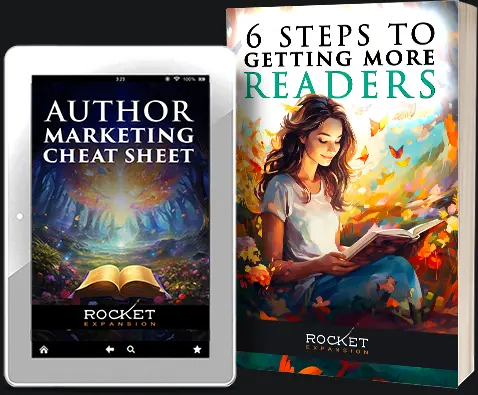How To Write A Winning Book Proposal

Your book idea sounds amazing in your head, and even on the page, but you don’t know if a publishing house will feel the same.
But it’s not enough to tell them about your book and cross your fingers.
The publishing industry may seem like a dream factory for aspiring authors, but they’re a business like any other.
So you have to speak their language – with the help of a book proposal.
We’re going to guide you on how to write a book proposal that sells yourself and your book idea.
What is a Book Proposal?
A book proposal is a business document written to persuade a publishing house to invest in a book. A proposal must prove that the idea and author bringing it to life will be commercially viable.
It usually includes a summary of the book’s idea, sample chapters, your marketing plan, and an author biography.
And they’re not fun to write at all.
Because they’re nothing like the writing you do for your books, author newsletters, or social media posts.
Why Do You Need to Write a Book Proposal?
If they’re a big ol’ pain to write, why write them?
If you’re looking to pique the interest of a traditional publisher, you need an ironclad business plan for your book.
The book publishing industry is not what it used to be. Don’t get us wrong, it’s absolutely awesome to see authors self-publish their books, but the frequency and ease at which this is done has changed the publishing landscape.
Publishers can’t afford to produce a book that only sells 1000 copies in its lifespan. It doesn’t justify their costs and efforts.
They’re putting themselves on the line when they choose to publish a book, so that book has got to SELL.
So, to answer the question, you have to write a book proposal because:
- Publishers will get your book on the bookshelves (online or in bookshops), and you’re the one that gets readers to buy it. You need to prove that YOU can get your books to sell.
- The publisher is taking an economic risk to invest in your idea. You must show that your idea is marketable and needed by your target reader.
- You need to show them that you are a person meant for this form of publishing. This proposal is also a way of vetting authors to see if they can handle the processes.
And it’s for your own sanity. It will help organize your ideas about your book, giving you a better understanding of what you’re going to achieve with it.
Before You Draft Your Book Proposal
We wanted to answer some questions you may have before discussing how to write a book proposal.
Should I write my book first?
If your book idea is clear in your head but you’re unclear about whether it will have a shot in bookstores or on Amazon, you may opt to write your proposal first.
This is commonplace for most nonfiction book ideas.
But it also makes the most sense when you are a well-known person and want to see if it’s worth your time writing the book. For example, if you’re an influencer in your industry with access to a network of impressive colleagues.
However, if you’re less known or a beginner author, having a manuscript will give the publisher confidence that you’ll get the book done (plus they’ll get to see your writing abilities).
How many pages should it be?
Your book proposal should land somewhere between 10 to 25 pages excluding sample chapters.
If you have a complex idea in mind like an illustrative book, you may rack up 50 pages with your sample work included. But be weary to only include what is essential to the proposal.
How long will it take me to write it?
Considering the amount of research and thought that has to go into a book proposal, it can take you anywhere from a week to a month.
Do I need an agent?
Most publishing houses won’t accept your book proposal without a literary agent. There are some that will accept such a submission, but that information will be made clear on their website.
Agents are great for helping you get your foot into the door of a publisher. They usually have some connections and they’ll be able to help you pair your book with the most appropriate publisher.
They can even help you polish your book proposal in a way that makes it the most appealing to a publisher’s eyes.
If you don’t have an agent, you’ll need to send your book proposal to a potential agent and ask for their assistance.
Are there Submission Guidelines?
Each publishing house should have submission guidelines for a book proposal. Be sure to tailor your document to their requirements so that your book proposal isn’t turned away because you missed a detail.
What if I’m doing a Nonfiction Book Proposal?
For a nonfiction book, it can be acceptable to deliver the book proposal before you have your manuscript.
This is because your masterful writing matters less than the market value of your book’s premise.
For example, if your book’s topic is around mental health, you have to show how your book has a unique take and discusses information that no other book in the market does.
Plus, so much information can be found online so you have to provide information that can’t be found with an internet search.
What about Fiction Book Proposals?
For fiction, your book’s hook, and your writing skills matter A LOT.
Your manuscript will have to be completed before you submit your book proposal because the book idea will also be measured by how gripping your story is.
And you’ll most likely need to submit a query letter.
Note: Don’t keep your plot twists and story endings a secret when discussing your book in the proposal. You’re trying to get your book published, spoilers are part of the package.
Are Memoir Book Proposals different?
This type of proposal usually falls between a nonfiction and a fiction book proposal.
The writing and book’s marketability are of high importance here. Your story needs to be unique and as well as attractive to a particular audience.
A memoir proposal will be shorter than a nonfiction one because it’s less focused on market analysis and more on the author’s platform and story.
Therefore, the sample material you share will need to be substantial in showing off what makes the book compelling.
Note: If your story is more indie or very niche, consider avenues that don’t require a book proposal. Look out for publishers that don’t ask for proposals or even try self-publishing your book.
Formatting your book proposal
Unless specified differently by the publishing house, here’s the format to use when you write a book proposal:
- Spacing: Single-spaced text but double-spaced for your sample chapters
- Font: Times New Roman.
- Font size: 12 point
- Page size: 8,5’’ x 11’’
- Numbering: Each page including the sample chapters should be numbered in either the header or footer, with the exception of the title page.
- Digital copy: In DOCX file format.
- Physical copy: Do not punch holes or staple the pages. Only bind it with a paper clip or any other method that does not keep the pages stuck together.
One last thing to note
Before putting pen to paper (or fingers to keyboard) make sure your idea is fully fleshed out. For your book proposal to have the best chance at success, you need to be able to communicate your book’s idea with clarity and ease.
You must have complete faith in your idea and you need to believe it’s the best thing since sliced bread to get the publisher to buy into it.
How to Write a Book Proposal
Next up: the sections of a proposal. Not all sections will be applicable to each type of proposal or every publisher’s submission requirements. But these are the usual sections used when you write a book proposal:
1. Title page
Include your book title, author name, email address, author website, and phone number.
Header/Footer of each page
Simply put your book title and author name.
2. Write a gripping overview
As with other proposals, or any other sort of hefty assignment you may have done for school, this section is usually done last but appears first.
In business terms, this is like an executive summary, and it can be 1-3 pages.
This section is the publisher’s first impression of your book proposal. Your aim here is to summarize and make the publisher want to keep reading – instead of only feeling obligated to skim through with no interest, or worse toss it in the rejection pile.
The beginning paragraph is almost like writing a book blurb. Try to describe your book like you envision yourself doing once your book is published. You want to compel future readers to buy it, right?
Use this gusto while adding key details that define the story, genre, and what the reader will get out of this book.
Lastly, add the key details from the other sections in your book proposal. This could be your author platform, information on your target audience, etc.
Note: Don’t go into too much detail about your book here. You don’t want to risk repeating content and losing the publisher’s interest. Stick to what the publisher would want to know at this point before laying out your full business case.
3. Compile your chapter outline
If you have completed your manuscript, this section may be easier to draft.
Here is where you’ll list out each chapter in your book with a quick description of what will occur in each. You’ll need to show how the story goes from start to finish so that the publisher will understand the structure and impact.
But don’t panic about committing to this outline. The publisher knows that this is not the final book and the story may evolve.
This section will be about 3000 words long, with about a paragraph per chapter.
4. Write your author bio
Repeat after me: “I’m the author who’s meant to tell this story.”
No, come on say it and mean it.
You are the author that’s meant to tell this story!
Now, use this section to convince the publisher of this.
Any proof that you have that argues this point must be included here. This is not your regular ‘About The Author’ section where you go on about how you met your partner and got your new puppies (unless you’re writing a children’s book about your puppies).
This section is about selling yourself. What works have you done that makes you an expert on your book’s idea, or what articles have you published around similar topics?
Have you had a book published in the past? Mention that here! Don’t be afraid to go into details of why it was a success or why it wasn’t (and how you’ll improve).
If you have experience with speaking engagements or have an engaged following on any social media platforms, make sure to highlight that here.
Keep this section to around 1 page max.
Note: If you’re lost on how to begin, you can start by using your author bio which would be on your author website – cute puppies and all. Then add in any expertise and experience you have that gives you credibility. Once you’ve written your first draft, take an axe and chop off what doesn’t serve your proposal’s purpose.
5. Highlight your target audience
It’s nice to think, “Well, everyone would like my book.” But no matter how appealing your idea is, statements like that won’t get your book published.
The publishing house will be more likely to accept your book proposal if it’s crystal clear who your book will appeal to.
When defining your target audience, think about the following:
- The possible age groups.
- Professions and hobbies (if applicable to your book idea).
- The type of forums they interact with.
- The social media platforms they use and the profiles they may follow.
- Their lifestyle.
- Other books of interest.
For example, if your book is about parenting methods for younger parents, your ideal reader would be on parenting forums and be in the age group of under 25.
You need all of this information to pinpoint your target audience to the publisher and then show how your book fits into this world perfectly.
You’ll need about 1 page for this section.
6. Compare comp titles
You’ve proven there’s an audience for your book, but the publisher may say that there are lots of books like this. They need to see how your book differs from the competition and why the readers will value it.
Put together a list of 5-10 books from the competition, and completely ROAST them!
We’re kidding. Never ever do that. EVER.
The aim of this section is to show how your book approaches the topic in a new light. Be professional, respectful, and analytical here.
Word gets around in the industry, so don’t make enemies because of what you said in a book proposal.
For each comp title, you need to include the following information:
- Title of the book
- Subtitle
- Author name
- The publisher
- Year it was published in
- Number of pages
- The current price
- The first published format (paperback or hardcover)
- The ISBN
- Book’s blurb
Spend around 250 words per title objectively talking about how each falls short and how your book fills the gaps.
Note: Remember to compare apples to apples and oranges to oranges. Comparing your book to a classic or an industry legend’s work may have your book proposal laughed off the table and into the garbage. Be realistic and always back the claim with proof. If you’re stuck, search on Amazon and Goodreads for recent titles in your genre.
7. Draft your Marketing Plan
Many authors are willing to do media appearances and all sorts of other marketing or PR work to market your book. Publishers know this.
What they do want to know is what you are already capable of doing to promote your book.
You need to show them what you’ve got cooking in your pipeline. This could include:
- How you could use your blog to get exposure for your book
- Using your email list to ask your audience for book reviews
- Your author website for online presence
- Your social media strategy for book promotion
- What your network of famous friends would do to add to your book marketing strategies
- Organizations you are a part of that will help boost your book’s exposure
- Any videos or podcasts you have or have been a part of that could be used
- Any previously published books you may have
Add any corresponding statistics to go along with your marketing plan to further solidify it. For example, open rate for your newsletter, attendance for past book signing events, views on videos posted, comments under your guest posts or blogs, etc.
Note: If you’ve done events before, include a schedule in your book proposal for future events and how you plan to sell your book during these.
8. Showcase your sample chapters
Finally! Time to let the reason for your book proposal in the first place shine: Your book!
How you pick your sample chapters differs from proposal to proposal. The genre plays a big role too.
Here’s a simple guide you can use to pick your sample chapters per genre:
- Nonfiction books: You’ll need to include the Introduction and 2 sample chapters.
- Narrative nonfiction books: The writing counts so you’ll have to put your best sample chapters forward and showcase your writing prowess.
- Fiction books: Instead of sample chapters, you’ll need to submit the first few chapters or 50 pages of your manuscript.
- Memoir books: Pick your best chapters where your writing and story are at its highest quality.
- Narrative Memoir books: If your memoir follows a narrative structure, then share the first few chapters.
In some situations, you may need to submit your entire manuscript. Make sure you’ve given it a good comb over before attaching it to your book proposal.
9. Include additional information
If you’ve thought of any additions that could increase your book proposal’s success, here’s where you put it.
This extra information could be:
- Review blurb idea: If you have someone in mind to give you a punchy review blurb, let the publishers know.
- Manuscript schedule: If your manuscript isn’t complete, give the publisher an estimate of when you can get it done (this shows your commitment and capabilities).
- Word count: Give an estimate of how many words you think your final draft should chalk up to; but remember, the longer the word count the more money needed to invest in your book.
- Book Layout: If you’ve dabbled in design or have a designer friend, consider adding a sample that shows how you envision your book cover.
Book Proposal Template
To get you started, we’ve included a template to help you write your book proposal:
Extra Tips For Writing a Successful Book Proposal
We thought we’d include a few extra tips to help you enhance your book proposal:
- Book description: If you’re stuck, call up a friend or family member and tell them about your book idea to see how you describe it – then use that as your first draft.
- Tailor the comp titles list to the publisher: Use previously published books by the publisher to show you’ve done your research and know there’s a market for your idea.
- Build your platform: If you don’t already have one, start building your brand and growing your audience online while you workshop book ideas.
- Keep it relevant: Any information you add should be relevant to the book proposal’s cause.
- Boast, but not too much: You need to accurately depict your expertise and ability to write this book but don’t go to the extreme end and make the publisher roll their eyes.
- Readers’ needs are a priority: You’re writing your book for the readers, so make sure you highlight how your book will impact them.
- Table of contents: Ensure there are links that let the reader of the proposal jump to the specific page from the table of contents. Show the publishers you know how to work a digital document.
- Proofread, and then proofread again: Make sure your book proposal is airtight and free of any errors. Once you’re done proofreading it yourself, ask your agent and friends to give it a read.
Common Mistakes to Avoid in Your Book Proposal
These are some mistakes you MUST avoid when you write your book proposal:
- Making it all about the book’s synopsis: Your book actually forms a smaller part of this than you’d first expect – remember to focus on proving why this book needs to be published.
- Unaware of competition: It’s important to read the competition’s books so that you know you’re not repeating an idea or any concepts by accident.
- Stale content: The world is ever-changing, so your idea should reflect this with up-to-date, modern information. Keep it current where applicable.
- Bad book idea: For example, the book idea is not unique enough or is too general – make sure your book idea is fascinating and specific.
- Wrong publisher: For example, when the author has approached a large publisher with a very niche concept. Look for publishers that have published similar works to your idea.
- Unclear chapter outline: Don’t label your chapters in a quirky way, be specific so the publisher can read with ease.
What to Do Next
Once you’ve gotten your book proposal submitted, it’s in the hands of the Publishing Gods.
It’s a very tricky business so remember to keep positive and learn from every experience. There are always other publishers and other avenues to help get your book out there, so keep hustling!
If you need help with building your author brand and online presence, we specialize in building author websites that represent the author perfectly.
We’ve seen many authors blossom and we’d love it if you were one of them. Inquire here if you’re ready to start your online author journey off right.

Want help with your author marketing? Get our FREE ebook and cheat sheet: 6 Steps To Getting More Readers.
By subscribing, you agree to get emails from me, Matt Ziranek. I’ll respect your privacy and you can unsubscribe any time.






